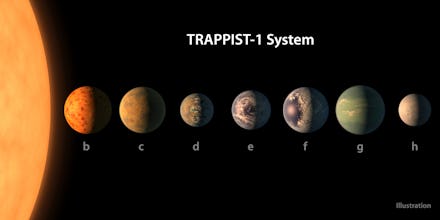According to NASA, a neighboring star has 7 Earth-like planets in its orbit

Seven Earth-like planets have been found orbiting a sun not too far — in space terms, at least — from our own.
NASA announced Wednesday that the planets resemble Earth in composition and spacing from their star, which means their conditions might be favorable to liquid water and life, Time reported.
"The planets form a very compact system," Michaël Gillon of Belgium's University of Liège, who led the research team, said in a teleconference, according to Time. "They are very close to their star and are reminiscent of the system of moons that orbit Jupiter. They could have liquid water and life."
Astronomers studied the star, Trappist-1 — which, at 39 light years away from Earth, is considered a relative neighbor — for six years, using telescopes located all over the world, plus the Spitzer Space Telescope. Their work was published online in the journal Nature on Wednesday.
According to Science Alert, researchers believe Trappist-1 and its orbiting exoplanets to be a "sister solar system" to our own because the planets are of similar mass, have a comparably rocky make-up and, notably, all have surface temperatures that could sustain life.
But the question as to whether there's extraterrestrial life on these planets is still very much a hypothetical, as Time pointed out. Trappist-1, a red dwarf star, is both smaller and colder than our sun. The planets that orbit it are clustered more closely, and they probably only ever face Trappist-1 from one side. Red dwarves are also more subject to solar flares than are big yellow stars like ours, which could be ruinous for closely circling planets.
For readers who might be eyeing a move to one of the seven planets in light of our possible impending doom, there's bad news: According to Time, the planets would take 39 years to reach, at best.